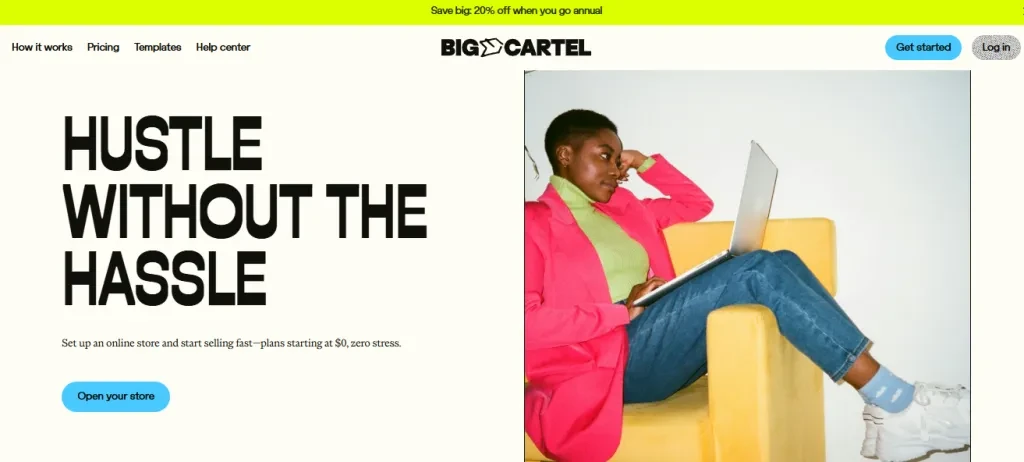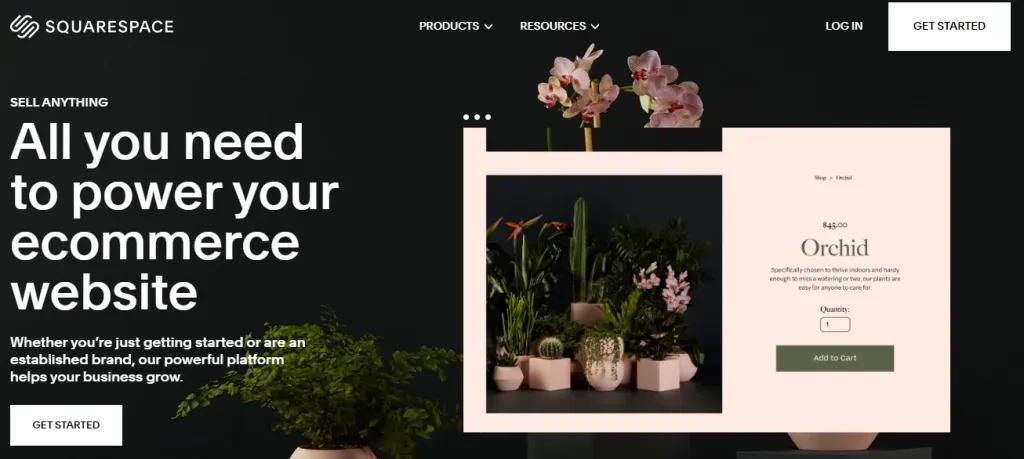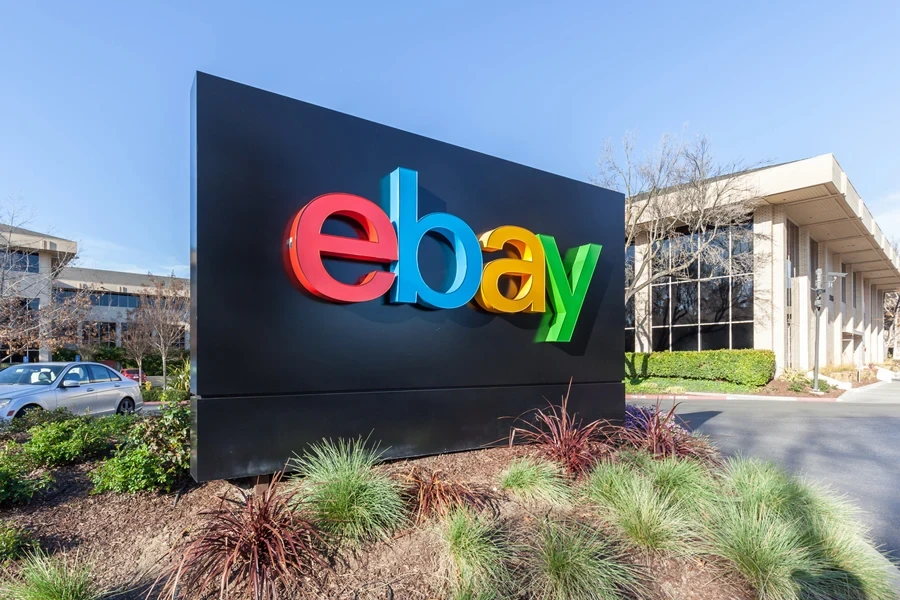Etsy changed how the world shops for handmade goods. Today, the craft economy has grown far past a single venue. While Etsy remains one of the giants in this space, many creatives type “Etsy alternatives” into Google every month for various reasons, such as comparing to see which offers are better. At the same time, new platforms continue to emerge, each with its own fee model, audience, and setup curve.
If you’re looking for websites similar to Etsy or wondering where to sell handmade items besides Etsy, the good news is that you have many options this year. Keep reading to find five of the best Etsy alternatives for sellers.
Table of Contents
A quick look at Etsy’s history and what it does
5 Awesome alternatives to Etsy to consider in 2025
1. Shopify
2. Amazon Handmade
3. Big Cartel
4. Squarespace Commerce
5. eBay
Wrapping up
Frequently Asked Questions
A quick look at Etsy’s history and what it does
Etsy was launched in Brooklyn in mid-2005, when blogging culture was booming and MySpace still ruled social media. It solved a simple problem: artists and crafters lacked an easy, low-cost way to sell online without learning code or negotiating high credit-card rates. A twenty-cent listing fee and a sub-four-percent commission felt refreshingly gentle, and word spread across many creatives forums and boards.
One amazing thing about Etsy is that its sellers are not large retailers or manufacturers—they’re passionate hobbyists or full-time artists building their livelihoods on the platform. Part of what draws people to Etsy is the one-of-a-kind nature of the items, especially for shoppers looking for something a little more personal.
Unlike standard catalog photos, product images on Etsy often have a creative, editorial feel that reflects the maker’s style. Since we’re looking at the top alternatives, it only makes sense that they have some of these qualities. So, here’s a super curated list.
Etsy alternatives: 5 amazing options to consider in 2025
1. Shopify

First, we have Shopify, which behaves less like a marketplace and more like a modern lease on retail space. You rent software rather than physical walls, but the principle is the same: when you unlock the door, the shop is entirely yours to arrange. You pick colours, upload a logo, choose whether customers see prices in dollars or euros, and install email pop-ups or loyalty points.
That freedom comes with two realities you cannot ignore. First, traffic is not bundled in as it is on Etsy, so you can’t just set up your store and leave it. Most successful Shopify sellers learn Facebook ads, Instagram reels, Pinterest idea pins, or old-fashioned e-mail newsletters to market their stores and get more sales.
Second, the cost for sellers shifts from a per-item to a flat monthly fee, depending on your chosen plan. Who thrives here? Makers with repeat-purchase goods—they’ll love the customer data access.
You can easily email buyers when you have a new line, something Etsy’s policies discourage. Artists offering higher-ticket originals also benefit because they can drop transaction fees dramatically once volume rises, especially when you upgrade your Shopify plan. Moreso, Shopify has improved its plan to enhance print on demand (POD) with its partnership with PrintKK.
2. Amazon Handmade

If you love Amazon, you won’t be disappointed to know they have a maker-only section: Amazon Handmade. Amazon Handmade is Amazon’s space for artisans to showcase and sell their handcrafted goods. Makers can create their storefronts and use FBA to take the hassle out of packing and shipping.
One good thing is that listings stay active and won’t expire, which helps sellers access helpful performance insights. And if you want to reach more shoppers, you can always use sponsored ads to boost your product’s visibility. You’ll also enjoy access to Amazon’s detailed analytics and marketing tools.
Remember that Amazon Handmade’s fees can be way more expensive than Etsy’s. After all, Amazon charges a 15% commission on each sale, and don’t forget the monthly membership fee. It’s not all bad, though, as you won’t battle with hidden or additional listing/payment process fees. Still, if you can handle the highest overall cost, Amazon Handmade’s convenience may be worth it. So, when it comes to Amazon handmade vs Etsy; there are pros and cons for sellers. Hence, it’s ideal to weigh them and know which favors you more.
3. Big Cartel

Big Cartel is another huge Etsy competitor that has been around since 2005. The platform targets artists and independent creators looking to sell their work in a simple online store. You’ll also have full control over how your brand feels and looks.
Here’s something interesting: Big Cartel knows they’re an Etsy alternative, so they offer a seamless way to move your Etsy listings to your Big Cartel store in mere minutes. They also have zero listing, transaction, and payment processing fees (remember that credit cards, Stripe, and PayPal will still charge).
While there are no hidden fees, Big Cartel offers different pricing plans. Their free tier allows you to list five products with one image per item, while their $15 plan bumps it up to 50 product listings with five images per product. With their $30 plan, you can get up to 300 product listings and 25 images per product. While marketing is up to you, hosting costs are predictable and reliable.
4. Squarespace Commerce

Squarespace began as a portfolio builder, and while it didn’t lose that DNA, it evolved into offering sellers multiple features to help them sell and manage their products online. With Squarespace Commerce, you’ll get access to many online store templates, meaning you can easily create amazing product arrangements and sales promotions.
While Squarespace charges a transaction fee on every sale, the fee depends on the plan you subscribe to. For instance, if you choose the commerce plan ($40/mo for basic or $72/mo for advanced), the transaction fees drop to zero.
Squarespace Commerce is quite the versatile Etsy alternative, as you can sell a wider range of products. It’s a great choice if you’re looking for something more professional with a suite of customization options. Remember that you’ll also be responsible for advertising and marketing your store.
5. eBay

eBay turns twenty-nine this year, yet its reach in the online marketplace sector remains formidable. Unlike Etsy, where every listing must claim “handmade” or “vintage,” eBay permits any legal good, which means your handcrafted items may sit beside random items, like phone chargers.
That approach has its advantages and disadvantages. You just need to know how to sell on eBay. But, on the good side, you can attract browsers looking for collectibles, especially if they stumble onto your listing. However, purists hunting a curated craft vibe may not even wait to reach your listing.
However, if you love eBay’s ability to turn any listing into an auction or “Buy it Now,” it’s a great place to sell rare and once-in-a-lifetime products (basically any special, handcrafted item). If you’re lucky, collectors may drive the auction price skyward, giving you sales up to triple the fixed cost.
Just remember that eBay is not as easy to customize as other platforms, as you’ll need some knowledge of HTML. Also, eBay charges you a listing fee (free for the first 250 listings, then $0.35) and a final value fee (which eBay calculates as a percentage of the sale + $0.30/$0.40).
Wrapping up
Choosing among these five Etsy alternatives for sellers is less about crowning a “winner” and more about matching platform character to maker personality, product category, and growth horizon. Many artisans keep their feet in two or three places to keep their options open. As volume climbs, production often becomes the next bottleneck.
If that day arrives and you need bulk supplies, remember that retail-marketplace choice and supply-chain choice are separate levers. If you plan to scale your craft business and need affordable raw materials, sourcing in bulk from platforms like Alibaba.com might be an option. Here is a clear walk-through of that process: How to order in bulk from Alibaba.com.
Whether you remain loyal to one marketplace or spread across several, the constants stay the same: clear photos, honest descriptions, prompt fulfilment, and a product born from genuine craft skill. With those pillars in place, any platform can become a profitable stage for your work in 2025 and beyond.
Frequently Asked Questions
Suppose we measure it by the size of its handmade-only catalogue and global recognition. In that case, Amazon Handmade currently represents the closest direct competitor, though its structure differs slightly from Etsy’s peer-to-peer roots.
“Better” is situational. Sellers seeking quick organic traffic often keep Etsy. Those prioritising brand control and customer data tend to layer in Shopify, Squarespace, and other alternatives.
Amazon Handmade’s 15% referral fee is higher than Etsy’s 6.5% transaction rate, but Etsy charges listing renewals and may place compulsory ads that deduct additional percentages. So, the cost advantage swings with item price and ad strategy.
Many sellers say yes to exposure alone, provided they treat it as one leg of a multi-channel stool. 2025 is packed with policy shifts and search-algorithm volatility, so diversification is a great way to help cushion the effects..
Etsy lets newcomers validate demand quickly without tech overhead. Shopify offers room to scale with full branding control. A common progression is open on Etsy, gather market proof, then launch a Shopify site once you get enough customer emails to justify targeted marketing.





 Afrikaans
Afrikaans አማርኛ
አማርኛ العربية
العربية বাংলা
বাংলা Nederlands
Nederlands English
English Français
Français Deutsch
Deutsch हिन्दी
हिन्दी Bahasa Indonesia
Bahasa Indonesia Italiano
Italiano 日本語
日本語 한국어
한국어 Bahasa Melayu
Bahasa Melayu മലയാളം
മലയാളം پښتو
پښتو فارسی
فارسی Polski
Polski Português
Português Русский
Русский Español
Español Kiswahili
Kiswahili ไทย
ไทย Türkçe
Türkçe اردو
اردو Tiếng Việt
Tiếng Việt isiXhosa
isiXhosa Zulu
Zulu